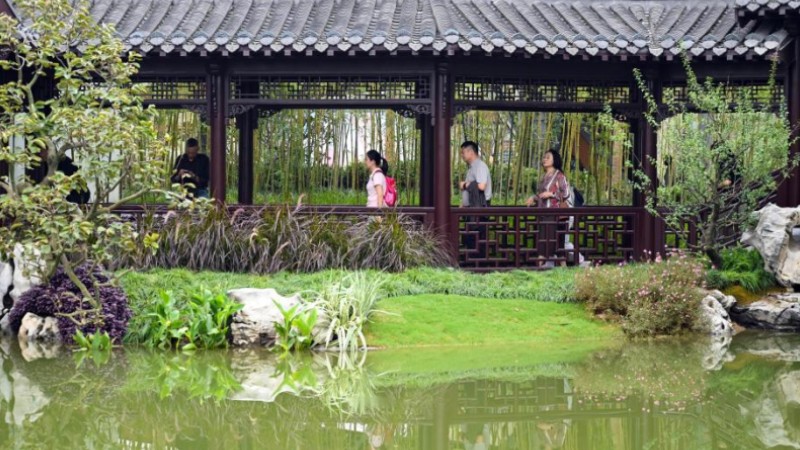Only BRI truly meets infrastructure needs

[Photo/Xinhua]
The 10th anniversary of the Belt and Road Initiative marks its coming of age amid rising geopolitical tensions. The ambitious global endeavour of an unprecedented scale has weathered through its first decade with much vigor despite the immense challenges.
The multitude of orchestrated disinformation designed to discredit it with such malicious labels as "debt trap" has failed to hamper the Belt and Road Initiative's momentum. The incessant insidious vilification of the initiative by the West has failed to slow its progress in infrastructure development. As of June 2023, China has signed more than 200 agreements with 152 countries and 32 international organizations, including the 10 member states of the Association of Southeast Asian Nations, under the Belt and Road framework.
As the Belt and Road Initiative makes new inroads in Latin America, once dubbed the "backyard of the US", the post-pandemic Southeast Asia is now on the threshold of economic recovery with an escalating demand for infrastructure development. The latter's rail links are projected to grow by 20 percent with an extension of more than 1,350 kilometers by the end of 2024 as compared with that on January 2023, according to a Nikkei analysis of projects in countries such as Thailand, Vietnam, Malaysia, Indonesia and the Philippines.
While the BRI skeptics in the West continue to cast aspersions on the BRI infrastructure projects, little did they anticipate China-ASEAN goods trade volume in 2022 — the year when the Regional Comprehensive Economic Partnership agreement came into force — has posted an impressive increase of 15 percent year-on-year.
Alongside a respective increase of 26.7 percent and 15.5 percent in both the sea-borne and air-cargo logistics involved in the China-ASEAN trade, the whopping increase of 197.6 percent in rail logistics stands out to be the most remarkable. In this context, the China-Laos railway service inaugurated in December 2021 has its fair share of contribution to the quantum leap in the rail logistics.
These RCEP statistics mirror the compounding impacts of the RCEP implementation alongside the logistical connectivity provided by the BRI. The trillion dollar worth mega-endeavour is truly a game-changer in its own right as it seeks to transform the landscape of regional, if not, global connectivity in all respects.
A case in point is the China-Laos rail link. At one time, it was deemed a near insurmountable challenge in the pan-Asian railway project. Now it has emerged as the forerunner in setting the pan-Asian railway into momentum. Its immediate impact is that it has transformed Laos, a land-locked ASEAN member state, into a land-linked country, thus enhancing the economic competitiveness of the nation.
When the world is still reeling from the pandemic-induced floundering economy, the US-led West set their sights more on the number of new BRI projects rolled out and were quick in drawing the conclusion that the Global Development Initiative, among others, was rolled out at the expense of the BRI. The latter was said to be left at the back burner with fewer projects hogging the international limelight.
Yet, the truth lies in that the GDI serves as an enabling platform to make the BRI outreach multi-dimensional. The complementarity of both the BRI and GDI simply evades the radar screen of the critics as seen in the case of how the Regional Comprehensive Economic Partnership delivers the economic dividends by riding on the BRI's logistical connectivity.
When the endeavour goes global, cultural differences rooted in the existing civilizational disparity between China and the rest of the world have to be bridged in the interest of confidence building. Effective communication to promote mutual understanding remains central to the successful implementation of the BRI.
In this regard, intensified vilification against the BRI by the doomsayers is certainly not the least anticipated. Though the venomous "debt trap" conspiracy theory has been pronounced unfounded, it is still being resurrected repeatedly to satisfy the insatiable greed for egoistic pride among the "sore losers". The unnecessary disdain displayed is simply "sour grape" at work.
Be that as it may, new "mini-lateral" groupings, ostensibly sponsored by the US, are now entering the ring of infrastructure development, purportedly to help bridge the gap of global infrastructure finance which requires an additional $3.2 trillion or 2 percent of the global GDP annually to realize the United Nations 2030 Sustainable Development Goals.
The new kid on the block is the "India-Middle-East-Europe Economic Corridor", which was launched at the recent G20 Summit in New Delhi. It has been projected as a transnational rail and shipping route spreading across Asia, the Middle East countries and Europe.
Prior to this, the kick-off of the BRI in 2013 has sparked off a litany of fresh initiatives for infrastructure development that are touted as viable alternatives. The low- and medium-income countries in dire need for infrastructure development seem to have made an ideal ground for showering hopes and promises.
The "Expanded Partnership for Quality Infrastructure" promised by Japan in 2015, followed by the launching of the "Asia-Africa Growth Corridor" by India in 2017 were both remembered to have slid into another promise of harmonizing their initiatives with their QUAD partners, namely the US and Australia in 2020 on the platform of Blue Dot Network. This was further eclipsed by the "Partnership for Global Infrastructure and Investment" rolled out by the US and its allies in G7 in 2022.
Prior to this, the European Union was joining the fray when it launched the "Global Gateway" program in 2021 with a commitment to deliver a "values-driven, high-standard and transparent" infrastructure partnership to meet the global infrastructure development needs.
All these initiatives shared the same purpose of funding infrastructure projects in the Global South. But none has yet had anything substantive to showcase the promised model of high-quality infrastructure on the horizon.
From the global perspective, no party should ever be paranoid of healthy competition in the interest of humanity. The BRI has proven its prowess by delivery of projects on-schedule. After all, proof of the pudding is in the eating. Amid the rising politics of infrastructure, no amount of empty hubris and rhetoric could ever reshape the global infrastructure connectivity, but sincere commitment certainly does.
The author is president of the Belt and Road Initiative Caucus for the Asia-Pacific, and former transport minister of Malaysia.
Photos
Related Stories
- Interview: BRI propels inland Chinese municipality toward forefront of opening up: vice mayor
- Interview: Chinese initiatives promote development, peace worldwide, says AL official
- China to release white paper on Belt and Road cooperation
- China's action on and contribution to building global community of shared future
- Interview: Swiss business leader upbeat on BRI, Sino-Swiss economic cooperation
Copyright © 2023 People's Daily Online. All Rights Reserved.









